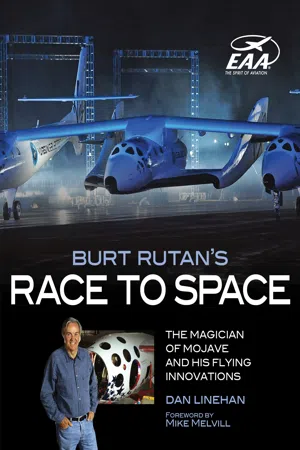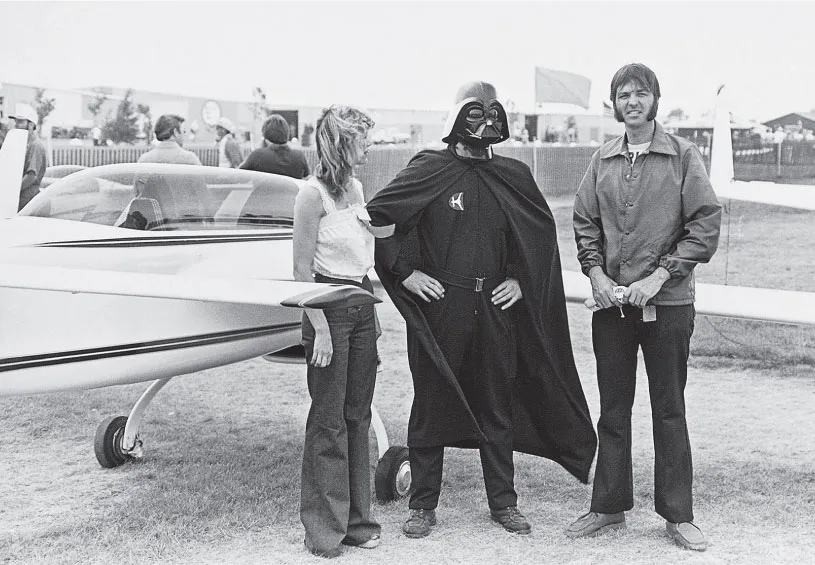![]()
Chapter 1 Rutan Lifts off the Ground
Burt Rutan wasn’t the first to use canards, but he certainly was the first to make an art form out of his planforms. The VariViggen, with its hammerhead-shaped nose, sweptback fighter-like wings, and external fuel tank, was the first airplane that he designed, built, and flew. Courtesy of Burt Rutan
Burt Rutan’s work on the F-4 Phantom proved to be a substantial influence not only on the first manned aircraft he designed and flew but also on many others to follow. The F-4 faced a deadly problem with unrecoverable flat spins. The only thing the pilots could do when trapped in this situation was to yank on the ejection handle, if they were lucky enough to have time to do so.
Rutan was able to help develop a procedure where pilots could reduce the probability of entering a flat spin after the aircraft departed from controlled flight, allowing them to return to base with the aircraft intact. In order to accomplish this, Rutan, in the backseat, and test pilot Jerry Gentry flew the fighter through more than a hundred departures—a departure is when the aircraft does not respond to the pilot’s control inputs—and normal spins with the aid of a specially designed spin-recovery parachute. They became the first ever to recover from a flat spin in an F-4 Phantom.
In an article Rutan wrote for Sport Aviation shortly after leaving the USAF, he stated: “Stall/Spin is the major cause of general aviation fatal accidents. NASA and the FAA are currently investigating the problem by evaluating and correlating the spin characteristics of current designs, evaluating new pilot training procedures, proposing instrumentation, and other methods. I feel strongly that too little emphasis had been placed on designing the overall configuration for safe high angle of attack flying qualities and that not all the important criteria are being considered.”
His solution to this was to create an aircraft that would not stall.
Designed during World War II but first flown after the war, the Convair B-36 Peacemaker was the largest bomber ever built. It proved to be an early inspiration to Burt Rutan. With a wingspan of 230 feet, the B-36A had six Pratt & Whitney R-4360 radial pusher engines. Modifications to later models included the addition of four jet engines. USAF
When Burt Rutan went to the store to buy his first model airplane, at an age too young for him to remember, his mother worried that he would become frustrated by not being able to put together the prefabricated parts. To her surprise, he returned with only blocks of wood and then carved his own airplane. Years later, he would go on to become a champion model airplane builder and flyer. Courtesy of Burt Rutan
Walt Disney (left) and Wernher von Braun (right) show off a model of the XR-1 that was featured in a three-part Disneyland television program that Burt Rutan watched as a kid in the 1950s. The XR-1 was the last stage of a four-stage rocket that von Braun designed to fly astronauts into orbit and then glide back down to Earth. NASA
During the twelve-year period shown in the timeline, Burt Rutan started his aerospace career as a flight test engineer at Edwards Air Force Base. He worked for Bede Aircraft afterward and then returned to Mojave to work full time on his own company, Rutan Aircraft Factory. Over this time, he made first flights on four models that he designed, one of which set the first of many world records his designs would come to earn. Dan Linehan
Burt Rutan’s futuristic design drew attention from the farthest reaches, even from a galaxy far, far away. Never noticed this before, but Vader also sports a serious set of sideburns. Courtesy of Burt Rutan
The Stall
It is extremely important to understand what a stall is and how a stall is caused because conquering the stall was the primary focus of Rutan’s early designs.
A stall occurs when air no longer flows smoothly over a wing, causing the wing to lose its ability to create lift. Without lift, airplanes don’t fly. They become big, giant falling objects. Stalls are especially dangerous at low altitudes, like when landing or taking off. A pilot needs time to correct the problem, and altitude equals time. Also, when a hazardous spin occurs, it is typically trigged by a stall.
So what happens to the air to cause it not to flow smoothly over the wing in the first place, eventually leading to a stall? A wing has a shape, known as an airfoil, specially designed to interact with the air to cause lift. This favorable interaction only occurs when the wing moves through the air within a range of orientations. Once outside this range, when the airplane’s angle of attack exceeds a critical value, the airfoil fails to properly provide the expected lift and the aircraft departs from controlled flight.
But angle of attack is the key term here.
Imagine a pilot flying straight and level. The angle that the aircraft makes with the oncoming air is the angle of attack. Or, more precisely, the angle between the relative wind and the chord line, which is a reference line drawn from the front edge of the wing’s airfoil cross-section to the back edge. If the pilot pulls the nose up and the aircraft is still flying straight and level, the angle of attack has increased. The angle that the aircraft’s nose points in relation to the direction of the air’s movement has increased. So if the pilot pulls back even more while still flying straight and level, the angle of attack becomes even greater. At some point this angle reaches the critical value and the air moving over the wing goes haywire.
Generally speaking, if the pilot pulls the stick back too much, causing the nose to rise too much, and airspeed is too slow, then the condition is ripe for a stall.
As a flight test engineer for the USAF, Burt Rutan (third from the right) performed his duties in the backseat of the McDonnell Douglas F-4 Phantom. A frontline fighter-bomber during the Vietnam War, the F-4 had a problem where under certain conditions it would depart into a nonrecoverable flat spin. Rutan helped devise a solution for pilots that used a drogue chute to avoid entry into the flat spin. Courtesy of Burt Rutan
Conventional Aircraft
Three views of a conventional aircraft flying straight and level but at different speeds: As speed decreases, the nose pitches up, but the direction of the oncoming airflow stays the same. A stall occurs once the angle of attack becomes too large. At this point, air can no longer flow smoothly over the wing, and the wing can no longer generate lift. Dan Linehan
The Canard
So Rutan sought to eliminate the dangers poised by stalls by effectively designing them out of the airplane. He did this with the canard, the little tail attached to the nose instead of the backend of the fuselage like on most other airplanes.
“I was entranced for some reason—I don’t know why—by the Saab Viggen,” Rutan recalled of the Swedish fighterjet back during his college days. “The B-70 hadn’t flown yet. There were pictures of it, this new, super, Mach 3 bomber that’s being built.”
Both these aircraft had canards. While still in college, Rutan did some canard building of his own.
“I found out with a RC model, and I found out by doing a little wind tunnel model, that I could get natural stall limiting. And I was absolutely fascinated by that,” he said. “Whether it was forward or aft CG, I could take the airplane full aft stick and run up to a certain angle of attack and then pull all you want and it doesn’t go higher. This is a big safety thing.”
As the end of Rutan’s USAF career neared, he began to work on the brand new F-15 Eagl...








